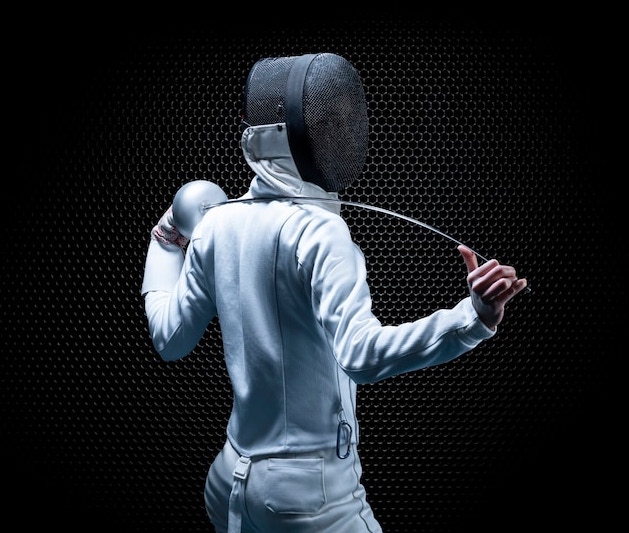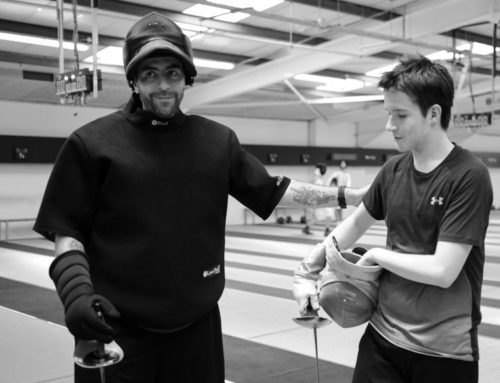Fencing is more than just swordplay. From the duelling grounds to the Olympic stage, fencing stands apart from other sports due to its fascinating history and philosophy. It intertwines the past with the present and connects us with the values and virtues of bygone eras. By delving into the historical roots of fencing, practitioners tap into a rich tapestry of tradition and cultural significance, allowing them to embrace the art of life through a deep appreciation of the sport’s historical and philosophical journey.
The history of fencing and its philosophy are intertwined and cannot be considered separately. Together, history and philosophy form a symbiotic relationship that shapes the essence of the sport. To better understand the philosophy hidden behind the mask, it is crucial to know the historical context.
This historical heritage imbues fencing with a distinctive blend of tradition, cultural significance, and refined techniques, setting it apart as a sport deeply rooted in centuries of martial arts tradition and noble pursuits. It echoes the codes of honor, chivalry, and nobility prevalent in societies long ago. The artistry and grace displayed in historical fencing techniques reflect the beauty and elegance sought after in every aspect of life. I want to briefly mention the prominent features of the impressive history of fencing:
Origins and Tradition
Fencing has a long and storied history that dates back thousands of years. It can be traced to ancient civilizations such as Egypt, Greece, and Rome, where swordplay and combat were integral parts of warfare and self-defense. The historical roots of fencing give it a distinctive connection to the past and a rich tapestry of tradition and cultural significance.
Role in Duels and Honor
Fencing was historically associated with dueling and matters of honor. Individuals would engage in one-on-one combat to settle disputes or defend their reputations in various periods. The strict codes of conduct, such as dueling protocols and adherence to chivalry, added a layer of formality and etiquette to the sport that set it apart from other athletic pursuits.
Influence on European Nobility
Fencing played a significant role in the lives of European nobility and aristocracy. It was considered an essential skill for gentlemen, emphasizing qualities like honor, courage, and mastery of one’s weapon. Fencing became closely associated with notions of nobility, elegance, and refinement, distinguishing it from other sports unrelated to social status.
Evolution of Fencing Schools and Masters
Throughout history, fencing schools and renowned masters emerged, developing and refining fencing techniques and styles. These schools, such as the Italian, French, and Spanish schools, played a vital role in shaping the evolution and distinctiveness of fencing as an art form. The influence of prominent fencing masters added depth, sophistication, and historical significance to the sport.
Integration into Olympic Games
Fencing holds the distinction of being one of the original sports included in the first modern Olympic Games when they were revived in 1896. This early integration into the Olympic movement solidified fencing’s place in sporting history, further elevating its profile as a sport with deep historical roots. Fencing remained 1 of the six sports consistently present in every edition of the modern Olympic Games.
You can learn more about the history of fencing on the “Quick Look Into The Past – The History” page, where sword fighting and its evolution into an Olympic sport are explained chronologically.
Another factor that keeps fencing apart from other sports is the way of keeping its history alive. The rules governing modern fencing in the disciplines of epee, foil, and sabre have been shaped by the rich historical heritage of the sport. Each weapon has its own set of rules and regulations, influenced by the traditions and evolution of fencing throughout history. Let me give you some examples from the rules of modern fencing that reflect the development of fencing techniques and weapons and preserve the heritage and spirit of the sport.
Epée
Derived from the duelling traditions of the past, it emphasizes the concept of “first touch,” where the whole body is the target area, and simultaneous hits are awarded.
Foil
Originating from the training weapon for duels, it focuses on precise target areas and the concept of right-of-way, where the fencer with the attacking advantage receives the point.
Sabre
It was inspired by the cutting and thrusting weapon used by cavalry soldiers. In cavalry combat, the entire upper body was considered a valid target due to the nature of mounted warfare. Cavalry soldiers aimed to strike any vulnerable area of their opponent’s upper body to incapacitate the enemy and disrupt their combat capabilities effectively. This included targeting the head, torso, and arms. As a result, the rules of engagement in cavalry combat determined the valid target area of today’s modern sabre.
Fencing’s rich historical roots, steeped in centuries of swordplay and combat, have given rise to a distinct philosophy centered around discipline, respect, and mastery. The ancient practices and traditions that have survived through generations inform the philosophical principles of fencing, emphasizing character development, self-control, and strategic thinking.
The sport’s historical context provides a framework for understanding these principles’ significance and relevance in modern times. By delving into the history of fencing, practitioners gain a deeper appreciation for the philosophical underpinnings that guide their training and shape their approach to competition and life. Through the fusion of history and philosophy, fencing becomes a physical endeavor and a profound journey of self-discovery, personal growth, and the pursuit of excellence.
Fencing transcends mere swordplay; it encapsulates a set of principles and philosophies that cultivate both the body and mind. At its core, fencing emphasizes precision, agility, and strategy, challenging participants to master a delicate balance between offense and defense. Three fundamental principles can summarize the philosophy of fencing:
Discipline
Fencing demands rigorous discipline from its practitioners. The sport requires unwavering focus, mental agility, and physical dexterity. By engaging in regular training and adhering to strict rules and regulations, fencers develop self-discipline that extends beyond the confines of the fencing piste.
Strategy
Fencing is often likened to a physical chess match, where participants must outmaneuver their opponents through calculated moves and quick reflexes. Fencers learn to anticipate their opponents’ actions, analyze patterns, and adapt their strategies accordingly. This strategic mindset hones critical thinking skills and the ability to make split-second decisions, which can prove invaluable in various aspects of life.
Respect, Honor, and Sportsmanship
Central to the philosophy of fencing is the value placed on respect, honor, and sportsmanship. Saluting holds significant importance in fencing, symbolizing these values. The act of saluting before and after a bout is a time-honored tradition that showcases the mutual respect between fencers. It is a gesture that recognizes the skill and dedication of one’s opponent, regardless of the outcome. Saluting also serves as a reminder of the historical roots and traditions of the sport, connecting fencers to the long lineage of fencers who came before them. By observing this tradition, fencers demonstrate their commitment to fair play and embody the values of integrity, discipline, and respect. Saluting in fencing adds an air of elegance and respect to the sport and reinforces the camaraderie and shared passion that binds the fencing community together. The sport instills a sense of fairness and dignity, promoting ethical conduct and good sportsmanship on and off the fencing piste.
In conclusion, the philosophy of fencing encompasses far more than just the physical aspects of the sport. It is a discipline that hones the body, mind, and spirit. Through the pursuit of excellence, respect for oneself and others, and the constant quest for personal growth, fencers embody the values of integrity, perseverance, and honor.
Fencing teaches us to embrace challenges, think strategically, and approach life with grace and agility. It is a journey that extends beyond the confines of the fencing piste, permeating our everyday lives and shaping us into well-rounded individuals. So let us heed the sword’s call, embrace the philosophy of fencing, and embark on a path of self-discovery, empowerment, and fulfillment.
As we draw our sabres, we engage in a thrilling sport and embark on a transformative and enriching journey that connects us with centuries of tradition, propels us to reach our full potential, and invites us to embrace the artistry and wisdom that fencing offers.



